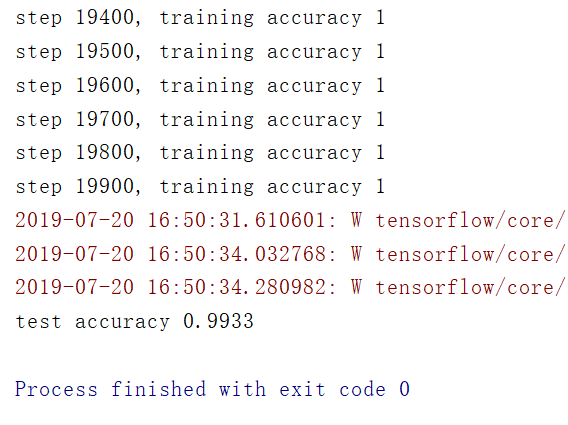from tensorflow.examples.tutorials.mnist import input_data
import tensorflow as tf
# 载入MNIST数据集
mnist = input_data.read_data_sets("MNIST_data/", one_hot=True)
sess = tf.InteractiveSession()
# 先定义好初始化函数, 该卷积神经网络会有很多的权重和偏置需要创建
# 我们需要给权重制造一些随机噪声来打破完全对称
# 比如截断的正态分布噪声, 标准差设为0.1. 同时因为我们使用ReLU,
# 也给偏置增加一些小的正值(0.1)用来避免死亡结点
def weight_variable(shape):
initial = tf.truncated_normal(shape, stddev=0.1)
return tf.Variable(initial)
def bias_variable(shape):
initial = tf.constant(0.1, shape=shape)
return tf.Variable(initial)
# 卷积层, 池化层接下来也要重复使用, 因此也定义创建函数
# [] 前面两个代表卷积核的尺寸, 第三个代表有多少个channel
# 最后一个代表卷积核的数量, 也就是这个卷积层会提取多少类的特征
def conv2d(x, w):
return tf.nn.conv2d(x, w, strides=[1, 1, 1, 1], padding='SAME')
def max_pool_2x2(x):
return tf.nn.max_pool(x, ksize=[1, 2, 2, 1], strides=[1, 2, 2, 1],
padding='SAME')
# 设置占位符
x = tf.placeholder(tf.float32, [None, 784])
y_ = tf.placeholder(tf.float32, [None, 10])
x_image = tf.reshape(x, [-1, 28, 28, 1])
# 第一层卷积 + 池化
w_conv1 = weight_variable([5, 5, 1, 32])
b_conv1 = bias_variable([32])
h_conv1 = tf.nn.relu(conv2d(x_image, w_conv1) + b_conv1)
h_pool1 = max_pool_2x2(h_conv1)
# 第二层卷积 + 池化
# 不同之处在于卷积核的数量变成了64
w_conv2 = weight_variable([5, 5, 32, 64])
b_conv2 = bias_variable([64])
h_conv2 = tf.nn.relu(conv2d(h_pool1, w_conv2) + b_conv2)
h_pool2 = max_pool_2x2(h_conv2)
# 连接一个全连接层, 隐含结点为1024, 并使用ReLU激活函数
w_fc1 = weight_variable([7 * 7 * 64, 1024])
b_fc1 = bias_variable([1024])
h_pool2_flat = tf.reshape(h_pool2, [-1, 7 * 7 * 64])
h_fc1 = tf.nn.relu(tf.matmul(h_pool2_flat, w_fc1) + b_fc1)
# 为了减轻过拟合, 使用Dropout层
keep_prob = tf.placeholder(tf.float32)
h_fc1_drop = tf.nn.dropout(h_fc1, keep_prob)
# 我们将Dropout层的输出连接一个Softmax层, 得到最后的概率输出
w_fc2 = weight_variable([1024, 10])
b_fc2 = bias_variable([10])
y_conv = tf.nn.softmax(tf.matmul(h_fc1_drop, w_fc2) + b_fc2)
# 定义损失函数, 使用优化器Adam, 并给于一个较小的学习速率1e-4
cross_entropy = tf.reduce_mean(-tf.reduce_sum(y_ * tf.log(y_conv),
reduction_indices=[1]))
train_step = tf.train.AdamOptimizer(1e-4).minimize(cross_entropy)
# 定义评价准确率的操作
correct_prediction = tf.equal(tf.argmax(y_conv, 1), tf.argmax(y_, 1))
accuracy = tf.reduce_mean(tf.cast(correct_prediction, tf.float32))
# 下面开始训练
tf.global_variables_initializer().run()
for i in range(20000):
batch = mnist.train.next_batch(50)
if i % 100 == 0:
# 预测时保留全部数据来追求最好的预测性能
train_accuracy = accuracy.eval(feed_dict={x: batch[0], y_: batch[1],
keep_prob: 1.0})
print("step %d, training accuracy %g"%(i, train_accuracy))
# 训练时, 随机丢弃一部分结点的数据来减轻过拟合
train_step.run(feed_dict={x: batch[0], y_: batch[1], keep_prob: 0.5})
# 全部训练完成后, 我们在最终的测试集上进行全面的测试,
# 得到整体的分类准确率
print("test accuracy %g" % accuracy.eval(feed_dict={
x: mnist.test.images, y_: mnist.test.labels, keep_prob: 1.0
}))
